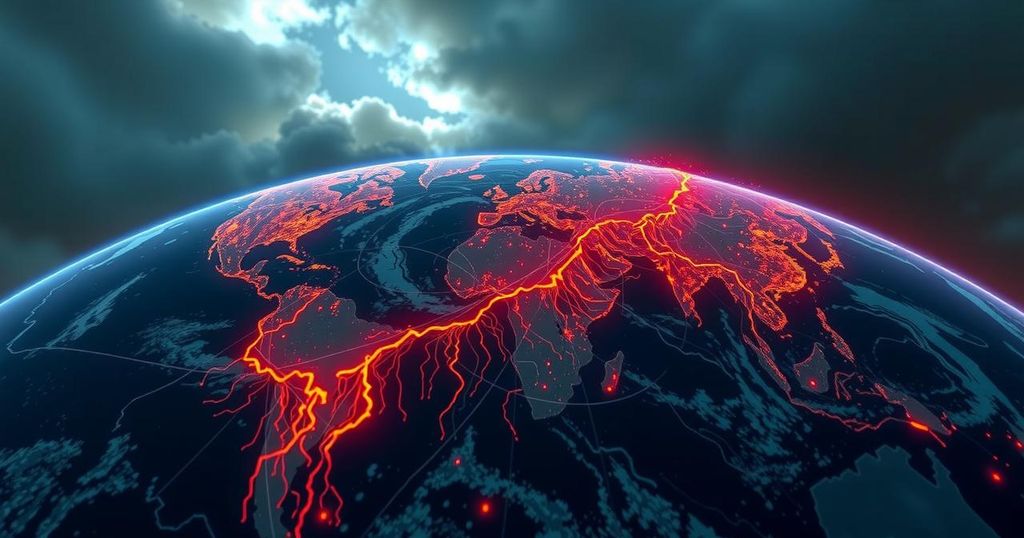Record Greenhouse Gas Levels Trigger Concerns for Global Warming

The World Meteorological Organization reported in 2023 that greenhouse gas levels reached record highs, unprecedented in millions of years, resulting in locked-in future temperature increases despite potential emissions cuts. CO2 levels hit 420 ppm, with methane and nitrous oxide also significantly elevated. Natural factors, including El Nino and wildfires, contributed to this surge, exacerbating climate change and highlighting the urgent need for effective global action ahead of the Cop29 climate summit.
In 2023, the World Meteorological Organization (WMO) reported unprecedented levels of greenhouse gases in the atmosphere, reaching concentrations not observed for millions of years. The spike in greenhouse gas levels indicates that future temperature increases are effectively secured, even if emissions are reduced to net zero. Specifically, carbon dioxide concentrations reached 420 parts per million (ppm), a level not seen for three to five million years, a period characterized by average temperatures 3 degrees Celsius warmer than today and sea levels up to 20 meters higher. “Another year. Another record. This should set alarm bells ringing among decision makers,” stated WMO Secretary-General Celeste Saulo. The report highlighted the pressing concern that global commitments to limit warming as per the Paris Agreement are clearly falling short. The rise in atmospheric CO2, recorded at 2.3 ppm last year, marks the twelfth consecutive year of increases surpassing 2 ppm, reflecting a staggering 151 percent rise compared to pre-industrial levels. Influential factors contributing to this increase included natural phenomena such as El Nino, exacerbated by extensive wildfires and enduring fossil fuel emissions. Consequently, the ability of forests and oceans to absorb carbon has diminished, leading to a compounding effect wherein climate change itself could turn ecosystems into net sources of greenhouse gases. WMO Deputy Secretary-General Ko Barrett elaborated, “Wildfires could release more carbon emissions into the atmosphere, whilst the warmer ocean might absorb less CO2. Consequently, more CO2 could stay in the atmosphere to accelerate global warming.” In 2023, carbon emissions from global fires reached 16 percent above the average, with extreme wildfire seasons reported in Canada and Australia experiencing its driest recorded months from August to October, which resulted in severe bushfires. Methane levels reached 1,934 parts per billion, reflecting a 265 percent increase from pre-industrial baselines, while nitrous oxide levels rose to 336.9 parts per billion, amounting to a 125 percent increase. CO2 is responsible for approximately 64 percent of climate warming, predominantly deriving from fossil fuel combustion and cement production. It is crucial to note that about half of CO2 emissions remain in the atmosphere, with oceans absorbing around one quarter and land ecosystems accounting for just under 30 percent. Variations occur due to climatic events like El Nino, which can reduce carbon uptake by flora, while La Nina may enhance it. The WMO emphasized that current greenhouse gas levels contribute to an overall warming increase of 51.5 percent since 1990, with CO2 responsible for four-fifths of this increase. Given that CO2 has a prolonged atmospheric lifetime, temperature rises are projected to continue for several decades, even with swift emission reductions. Saulo underscored the urgency for global action, stating, “Every part per million and every fraction of a degree temperature increase has a real impact on our lives and our planet.” The WMO’s findings are pivotal as discussions approach for the upcoming Cop29 climate summit in Baku, Azerbaijan.
The World Meteorological Organization (WMO) regularly monitors and reports on greenhouse gas levels, providing essential data on the state of the Earth’s atmosphere and climate. The report released in anticipation of the Cop29 climate summit highlights the alarming rise in greenhouse gases, which poses significant implications for global warming and climate change. Understanding the historical context of current greenhouse gas levels, particularly their unprecedented concentrations, is crucial to grasping the urgency of addressing climate change and the effectiveness of existing policies in curbing emissions.
The WMO’s report highlights the dire state of greenhouse gas levels, which are at historic highs, underscoring the gravity of climate change and the urgent need for concerted global action. Despite efforts to reduce emissions, the data indicates that temperature increases are already locked in, with around half of CO2 emissions remaining in the atmosphere. These findings serve as a stark reminder of the challenges ahead as world leaders prepare for discussions at the Cop29 summit.
Original Source: www.rfi.fr






